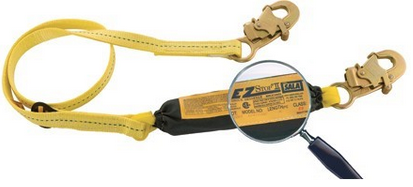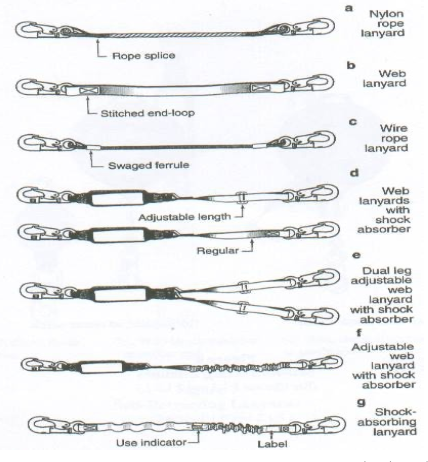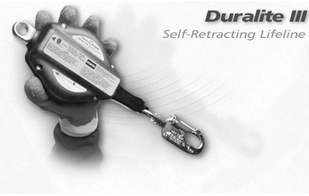7 Connecting Components
Connector means a device which is used to couple (connect) parts of the personal fall arrest system and positioning device systems together. It may be an independent component of the system, such as a carabiner, or it may be an integral component of part of the system (such as a buckle or D-ring sewn into a body belt or body harness, or a snap-hook spliced or sewn to a lanyard or self-retracting lifeline). All connecting components must comply with the latest version of CSA standard CSA Z259.12.: Connecting Components for Personal Fall Arrest Systems.
Carabiners and Snap Hooks
- Must be self-closing and self-locking
- Must require a minimum of 2 consecutive and deliberate manual actions to open
Connecting components, in general:
- Must be compatible with each other, to ensure safe function
- Must be compatible with work and environmental conditions
Connecting Hazards:
- Roll-out/burst-out due to gate loading
- Improper or incomplete engagement

Class 1 connectors
Connect a personal fall arrest system to an anchorage connector and/or to anchorage.
- Examples include snap hooks and carabiners. Can also include soft loops.
- Shall be marked with load rating, traceability of material, year of manufacture, CSA Z259.12, and load rating for the gate. Class 1 soft loops shall also be marked to indicate that they can be used with carabiners that have a 16kN gate, can be used with soft loops on lanyards, and are not to be used with snap hooks.
Class 2 connectors
Provided as approved components to integrate two or more parts of a personal fall arrest system, or incorporated into a personal fall arrest system at the time of manufacture. Examples include buckles, stitching and splicing.
CSA Z259.10-12 Full Body Harnesses requires that snap hook and carabiner gates must withstand a force of at least 3600lbs (16 kN).
CSA Z259.10-12: Full Body Harnesses states that large snap hooks and carabiners that have gate openings in excess of 19 mm (0.75 in) should not be used in conjunction with fall arrest attachment points on full-body harnesses. There is a strong possibility that an accidental rollout or burst-out (gate failure) could occur if the gates of such devices are loaded from the side.
Energy Absorbers and Lanyards
Energy absorbers and lanyards must comply with the latest version of CSA Standard Z259.11: Energy Absorbers and Lanyards.
Lanyards are attached to an anchor point, above the shoulder of the user, where practicable. The maximum free fall without an energy absorber is 1.22 m. Virtually all lanyards use energy absorbers to limit the maximum arrest force to no more than 8kN. Lanyards should be the shortest length possible, so that the user cannot contact an unsafe surface.

Energy absorbing lanyards elongate when subjected to an impact load. Careful calculation of total potential fall clearance is necessary in order to maintain a safe working environment.

E4 and E6 Fall Arrest Energy Absorbers: CSA Z259.11 creates two categories of energy absorbers, known as E4 and E6. An E4 energy absorber limits the arresting force to 4 kN under normal conditions and allows the arresting forces to increase to 6 kN if the energy absorber is wet or frozen. An E6 energy absorber limits the arresting force to 6 kN under normal circumstances, allowing it to increase to 8 kN when the energy absorber is wet and frozen. CSA created the two ratings to better protect workers of different body weights.
- The E4 energy absorber is intended for workers weighing 45-115 kg (100-254 lbs)
- The E6 energy absorber is intended for workers weighing 90-175 kg (200-386 lbs).
The 2017 version of CSA Z259.11 discontinued the E4 and E6 ratings for energy absorbers.
- Label must now include allowable freefall, mass range, etc.
- Label on absorbers designed for free fall heights 1.8 m or less must be white with black text, and for free fall heights of over 1.8 m, the label is black with white text.
Special Tie-back Lanyards
Special Tie-back Lanyards are produced by some manufacturers. Always follow manufacturers’ instructions when using these devices, and do not confuse them with lanyards that are not designed to be tied-back.
12-foot Free Fall Lanyards
12-foot Free Fall Lanyards are produced by some manufactures. These special 6-foot lanyards are used when the only available anchor point is at the worker’s feet. To keep the maximum arrest force below 8kN, a special energy absorber is used that has a greater elongation length. Do not confuse these lanyards with ones that are not designed for 12-foot free falls.
Self-retracting Devices
All self-retracting devices must comply with the latest version of CSA standard CSA Z259.2.2: Self-Retracting Devices for Personal Fall-Arrest Systems.
- Type 1: 1.5 – 3 m working length. Compact and light-weight.
- Type 2: a working length generally longer than 3 m. Must have a visual load indicator. Must follow annual inspection/maintenance schedule.
- Type 3: performs a fall arrest function as a type 2 device, plus has retrieval capability. Must follow annual inspection/maintenance schedule.

A self-retracting device must be:
- anchored above the user’s head unless the manufacturer’s specifications allow using a different anchorage location; and
- used in a manner that minimizes the hazards of swinging, and
- if the user falls, limits the distance they drop during the swing to 1.2m.
